
Ever wonder why some teams just click while others struggle? It’s not magic—it’s neuroscience. Neuroleadership, the study of how brain science impacts leadership and teamwork, is changing how we think about performance. And honestly? It’s about time.
What Is Neuroleadership, Anyway?
Neuroleadership blends psychology, neuroscience, and leadership theory. The idea? Understanding how our brains work can help leaders create environments where teams thrive. Think of it like tuning an engine—except the engine is the human mind.
Here’s the deal: our brains are wired for certain behaviors. Threat responses, social connection, decision-making—they all play a role in how teams function. Ignore them, and you’re fighting biology. Work with them? Suddenly, productivity feels effortless.
The Brain Science Behind High-Performing Teams
1. The Threat vs. Reward Response
Our brains are constantly scanning for threats—it’s a survival thing. In the workplace, threats might look like unclear expectations, unfair criticism, or even just a toxic email tone. When the brain senses danger, it triggers stress hormones. Creativity? Collaboration? They take a backseat.
But flip the script. Create a rewarding environment—recognition, autonomy, psychological safety—and dopamine kicks in. Suddenly, problem-solving feels… fun.
2. Social Brain = Stronger Teams
Humans are social creatures. Our brains are wired to connect. Teams that foster trust and camaraderie don’t just feel better—they perform better. Mirror neurons (those little brain cells that help us empathize) mean we literally sync up with our teammates. Ever notice how laughter spreads in a meeting? That’s neuroscience in action.
3. Cognitive Load and Decision Fatigue
Ever tried making a big decision after back-to-back meetings? It’s brutal. That’s because the brain has limited bandwidth. Neuroleadership suggests simplifying processes, reducing unnecessary choices, and scheduling critical thinking for peak mental energy times (usually mornings for most people).
Practical Neuroleadership Strategies
Okay, enough theory—let’s get tactical. Here’s how to apply neuroleadership today:
- Reduce threats: Clear goals, transparent communication, and constructive feedback keep the brain out of panic mode.
- Boost rewards: Celebrate small wins. Seriously—even a quick “great job” triggers dopamine.
- Encourage social bonding: Team lunches, casual check-ins, or even virtual coffee chats build trust.
- Respect mental energy: Limit meetings, batch tasks, and avoid decision overload.
The Future of Neuroleadership
As remote work blurs lines between personal and professional life, neuroleadership becomes even more critical. Burnout? It’s often a brain chemistry issue. Disengagement? Probably a threat-response misfire. The best leaders won’t just manage tasks—they’ll manage minds.
And here’s the kicker: this isn’t about manipulating people. It’s about creating conditions where humans—flaws, quirks, and all—can do their best work. Because at the end of the day, leadership isn’t about control. It’s about understanding.








